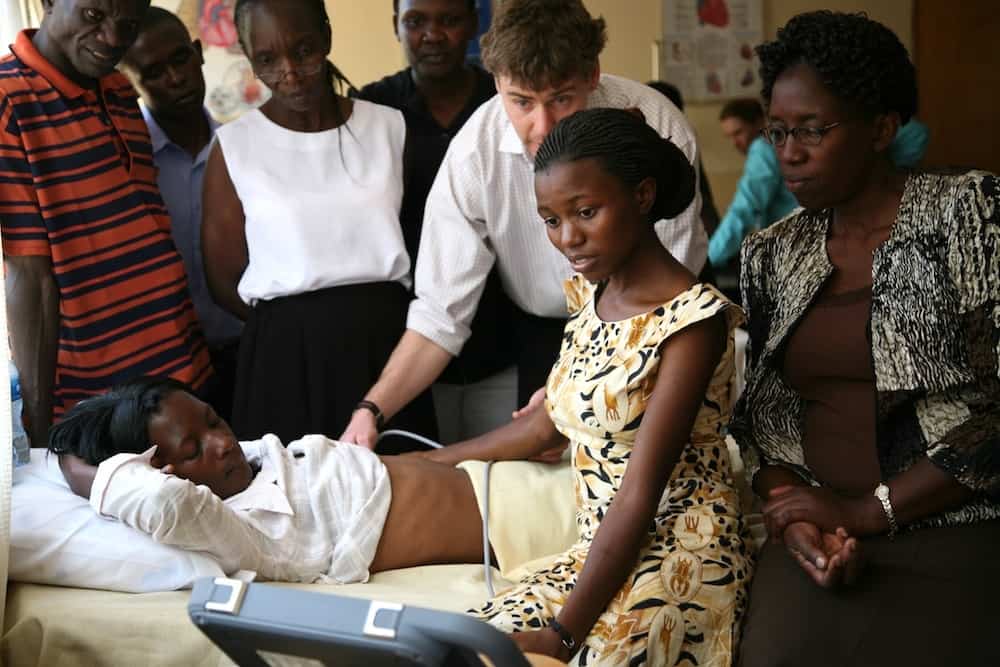SonoSite, the world leader and specialist in bedside and point-of-care ultrasound, today announced a partnership with the African Institute of Innovation and Technology (AIIT), a Kenyan education trust, to establish the first ultrasound education programme at Great Lakes University of Kisumu – a technology hub of East Africa.
The AIIT ultrasound programme is designed to provide physicians, midwives and clinical workers with greater access to ultrasound education, training and medical resources to improve the health and welfare of the people in the region.
“The AIIT ultrasound training experience fills a gap in medical management and empowers providers in East Africa to feel confident in their ability to answer medical questions with hand-carried ultrasound,” said Ben Harvey, MD, Resident, Department of Radiology, Massachusetts General Hospital.
“In countries that lack medical resources, hand-carried ultrasound is a practical imaging solution to look inside the human body for answers, which cannot be achieved by a physical exam alone. While teaching courses at Great Lakes University, it’s truly inspiring to see how excited the providers are about learning how to use hand-carried ultrasound. They understand the value of the technology and what it can accomplish for their communities – better patient care.”
More than 100 clinical officers, midwives and physicians have already attended the first ultrasound training courses at Great Lakes University. The programme is led by Thomas Burke, MD, FACEP, AIIT co-founder. Burke also serves as Chief of the Division of Global Health and Human Rights at the Department of Emergency Medicine at Massachusetts General Hospital.
Burke stated: “Ultrasound is the only imaging modality that can be made available in many areas of the world. At AIIT, we are discovering numerous opportunities for ultrasound to direct and improve clinical decision-making in East Africa.”
Each year, developing countries are devastated by millions of preventable deaths, mostly caused by a lack of medical resources and infrastructure. In particular, diagnostic imaging modalities are typically too costly for rural environments and access to trained clinicians is limited.
It is estimated that, in just one year, five million deaths occur from injury and trauma (90% occur in low and middle income countries) [1], 7.6 million children under the age of five die every day, 70% of these child deaths are in Africa and South-East Asia [2], and that pregnancy-related complications continue to be the single largest source of mortality for women of childbearing age in sub-Saharan Africa [3], accounting for more than 180 000 deaths per year [4]. A majority of these deaths could be prevented if healthcare providers had greater access to imaging modalities and training. This crisis in women and child health has attracted the attention of health ministries, and in 2000, as a part of the United Nations Millennium Development Goals, the programme declared that, by year 2015, its target is to improve maternal health and reduce mortality by 75% and to reduce under-five child mortality by two-thirds [5 and 6].
With advancements in ultrasound technology and system design, health organisations worldwide have recognised ultrasound as a valuable diagnostic tool for improving care and patient management in remote and resource-limited locations. Partners In Health, a non-profit organisation dedicated to providing improved health for poor and low-resource communities, declared that the “use of bedside ultrasound by healthcare providers has revolutionised care of patients worldwide, providing clinicians with immediate answers to clinical questions, and guiding procedures for improved safety [7]”.
Originally designed to meet US military specifications for durability and portability, SonoSite’s systems used in rural medicine are ideal to meet the demands of low-resource settings, passing a three-foot drop test, weighing less than 10 pounds, designed with battery operable functionality and engineered with a robust, lightweight magnesium shell. The systems are also affordable and intuitive for non-traditional users.
“Our belief is that education in ultrasound benefits all physicians and we are excited for the opportunity to partner with AIIT and support the mission for improved healthcare in developing countries,” said Kevin M Goodwin, SonoSite’s President and CEO.
“The school has attracted and trained 120 participants from South Sudan, Uganda and Kenya, and we have been contacted by health centers outside of East Africa that are interested in becoming involved in the programme. Our overall goal is to attract the interest of health ministries and NGOs, and expand the programme geographically to increase the availability of hand-carried, point-of-care ultrasound worldwide.”
To learn more about SonoSite’s involvement in rural medicine, please click here to access more information about our SoundCaring programme, making ultrasound systems available to non-profit healthcare providers in challenging environments around the world.
| SonoSite SonoSite (www.sonosite.com), a subsidiary of FujiFilm, is the innovator and world leader in bedside and point-of-care ultrasound and an industry leader in ultra high-frequency micro-ultrasound technology and impedance cardiography equipment. Headquartered near Seattle, the company is represented by 10 subsidiaries and a global distribution network in more than 100 countries. SonoSite’s small, lightweight systems are expanding the use of ultrasound across the clinical spectrum by cost-effectively bringing high-performance ultrasound to the point of patient care. 1 Gosselin, Richard A., David A. Spiegel, Richard Coughlin, and Lewis G. Zirkle. “Injuries: The Neglected Burden in Developing Countries.” Bulletin World Health Organisation 87.4 (2009): 246. National Center for Biotechnology Information. National Center for Biotechnology Information, US National Library of Medicine. Web. 5 February 2012. http://www.ncbi.nlm.nih.gov/pmc/articles/PMC2672580/. 2 “Children: Reducing Mortality.” WHO. February 2012. Web. 10 April 2012. http://www.who.int/mediacentre/factsheets/fs178/en/index.html. 3 “Giving Birth Should Not Be a Matter of Life and Death.” United Nations Population Fund Agency. UNFPA. Web. 10 April 2012. http://www.unfpa.org/sowmy/docs/maternal_health_fact_sheet_eng.pdf. 4 “Maternal Mortality.” WHO. Web. 13 April 2012. http://www.who.int/mediacentre/factsheets/fs348/en/index.html. 5 “United Nations Millennium Development Goals.” UN News Centre. UN. Web. 10 April 2012. http://www.un.org/millenniumgoals/maternal.shtml. 6 “United Nations Millennium Development Goals.” UN News Centre. UN. Web. 10 April 2012. http://www.un.org/millenniumgoals/childhealth.shtml. 7 Shah, Sachita, Daniel Price, Gene Bukhman, Sachin Shah, and Emily Wroe. Manual For Ultrasound in Resource-Limited Settings 1 (2011). Partners in Health. Web. 10 April 2012. http://parthealth.3cdn.net/6e013074d8f4c4c7d8_mlblfxb8q.pdf. Photos/multimedia gallery available: http://www.businesswire.com/cgi-bin/mmg.cgi?eid=50258712&lang=en |

